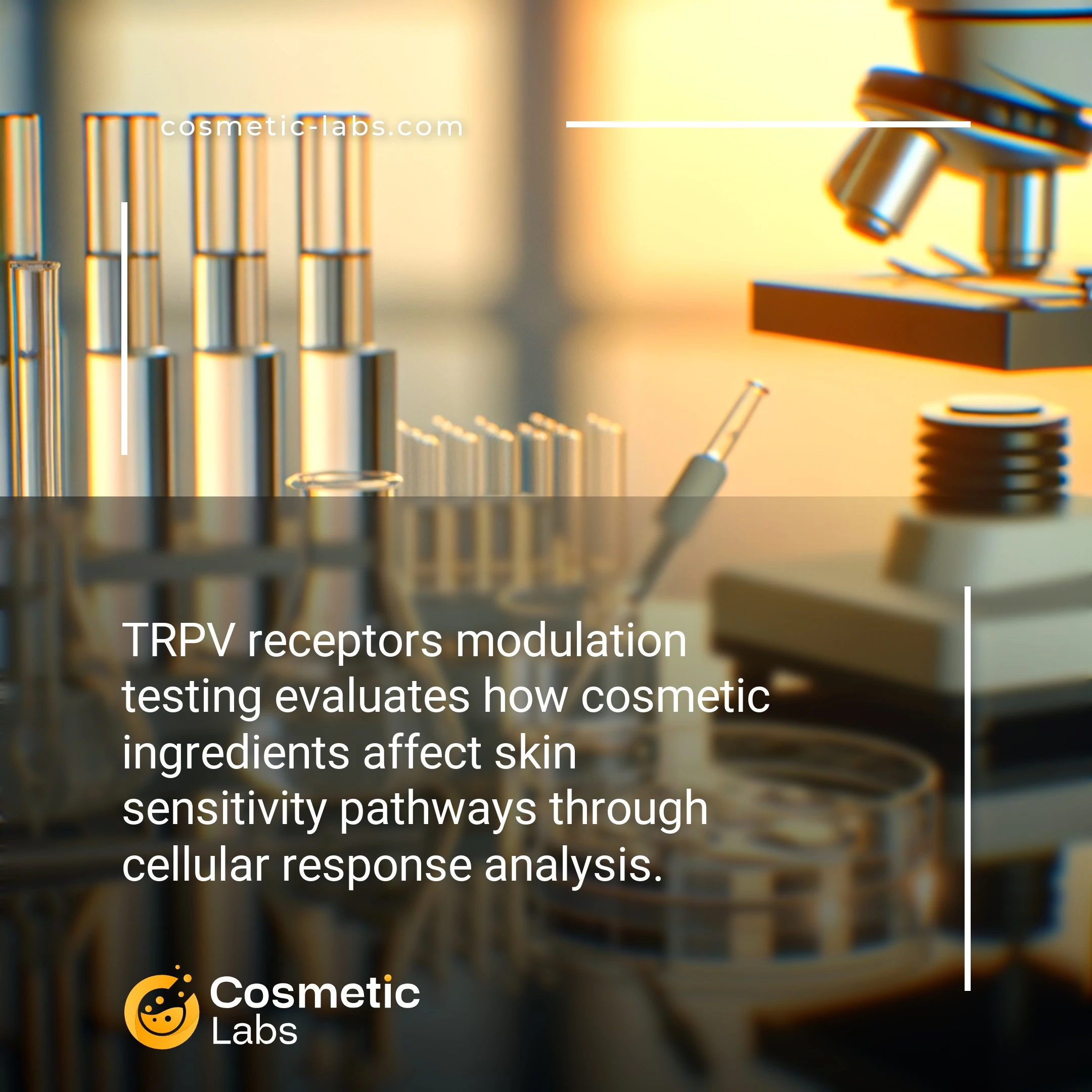TRPV Receptor Testing Services for Sensitive Skin Products

What is TRPV receptors modulation?
TRPV receptor modulation testing measures how cosmetic ingredients affect temperature-sensitive ion channels in skin cells that trigger irritation responses. Our partner labs use calcium imaging and patch-clamp techniques to evaluate whether your formulations can block TRPV1 activation from capsaicin or reduce TRPV3 sensitivity to heat, providing quantitative data on skin comfort enhancement before clinical trials.
Why do you need this service?
Cosmetic labs use TRPV receptor modulation testing to validate anti-irritant formulations before market launch, measuring how ingredients like niacinamide or ceramides reduce sensory discomfort in sensitive skin models. Brands rely on these assays to substantiate claims about reduced stinging and burning sensations, providing concrete data for regulatory submissions and consumer marketing materials.
Who provides TRPV receptors modulation services?
All cosmetic labs providing TRPV receptors modulation services
There is no company providing these services at the moment.
TRPV Receptor Modulation Testing for Sensitive Skin Products
TRPV receptor modulation testing helps brands develop products that calm sensitive skin by targeting specific ion channels responsible for irritation and discomfort. Labs on our platform use advanced assays to measure how formulations interact with TRPV1, TRPV3, and TRPV4 receptors, providing data you need for claims substantiation and product optimization.
Receptor-Specific Assay Protocols
Testing labs measure calcium influx responses when TRPV receptors encounter potential irritants or soothing ingredients. This approach identifies which compounds trigger sensitivity pathways and which ones block them. The data reveals your product’s ability to modulate pain and temperature sensations at the cellular level.
Standard protocols include:
- TRPV1 capsaicin challenge tests for heat sensitivity
- TRPV3 camphor activation assays for warmth perception
- TRPV4 osmotic stress evaluations for mechanical sensitivity
Skin Comfort Validation Studies
Labs combine TRPV receptor testing with human patch testing to validate real-world skin comfort benefits. This dual approach connects molecular mechanisms to actual user experience. You’ll receive dose-response curves showing optimal concentrations for maximum comfort without compromising product performance.
Testing typically covers ingredient screening, formulation optimization, and competitive benchmarking. Results support marketing claims about sensitive skin compatibility while meeting regulatory requirements for safety documentation.
Ready to validate your sensitive skin formulations? Connect with specialized labs on our platform that offer TRPV receptor testing services tailored to your product development needs.
Applications of TRPV Receptor Modulation Testing for Sensitive Skin Products
Beauty brands rely on TRPV receptor modulation testing to validate their sensitive skin formulations before market launch, ensuring products won’t trigger irritation responses in vulnerable consumers.
Anti-Aging Product Development
Cosmetic labs use TRPV1 and TRPV3 receptor assays to evaluate anti-aging actives like retinoids, peptides, and alpha hydroxy acids. These receptors detect thermal and chemical stimuli that often cause burning sensations in sensitive skin users. Testing protocols measure receptor activation levels at concentrations ranging from 0.1% to 5% active ingredient.
Labs typically run 48-72 hour exposure studies on cultured keratinocytes, monitoring calcium influx and inflammatory marker release. Results help formulators adjust concentrations to maintain efficacy without triggering discomfort. This testing reduces reformulation costs by 30-40% compared to traditional patch testing alone.
| TRPV Receptor Type | Primary Triggers | Testing Applications | Typical Assay Duration |
|---|---|---|---|
| TRPV1 | Heat, capsaicin, low pH | Exfoliant tolerance, warming products | 24-48 hours |
| TRPV3 | Warm temperatures, camphor | Soothing formulations, thermal comfort | 48-72 hours |
| TRPV4 | Osmotic stress, mechanical force | Barrier repair products, moisturizers | 72-96 hours |
Cleansing and Exfoliation Formula Optimization
TRPV receptor testing guides the development of gentle cleansers and chemical exfoliants for reactive skin types. Labs evaluate surfactant blends and acid concentrations using TRPV1 activation assays, since this receptor responds to pH changes and chemical irritants commonly found in cleansing products.
Testing reveals optimal pH ranges between 4.5-6.5 for sensitive skin cleansers, with TRPV1 activation remaining below 20% of positive control levels. Formulators can then select milder surfactants like sodium cocoyl isethionate or adjust buffering systems to maintain skin comfort. This data supports marketing claims about gentleness while ensuring effective cleansing performance.
Ready to validate your sensitive skin formulations? Contact specialized cosmetic labs on our platform to discuss TRPV receptor testing protocols tailored to your product development needs.
